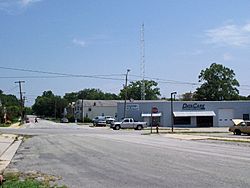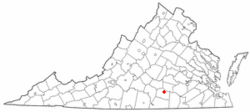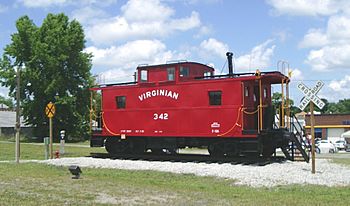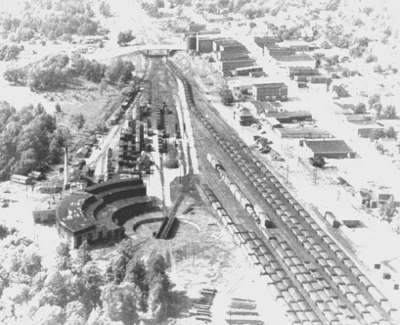Victoria, Virginia facts for kids
Quick facts for kids
Victoria, Virginia
|
|
|---|---|
|
Town
|
|

Street scene in Victoria
|
|

Location of Victoria, Virginia
|
|
| Country | United States |
| State | Virginia |
| County | Lunenburg |
| Named for | Queen Victoria |
| Area | |
| • Total | 2.85 sq mi (7.38 km2) |
| • Land | 2.82 sq mi (7.29 km2) |
| • Water | 0.03 sq mi (0.09 km2) |
| Elevation | 587 ft (179 m) |
| Population
(2010)
|
|
| • Total | 1,725 |
| • Estimate
(2019)
|
1,626 |
| • Density | 577.41/sq mi (222.92/km2) |
| Time zone | UTC−5 (Eastern (EST)) |
| • Summer (DST) | UTC−4 (EDT) |
| ZIP code |
23974
|
| Area code(s) | 434 |
| FIPS code | 51-81024 |
| GNIS feature ID | 1496356 |
Victoria is a small town in Lunenburg County, Virginia, United States. An "incorporated town" means it has its own local government. In 2010, about 1,725 people lived there. This number was a bit lower than the 1,821 people counted in 2000.
Contents
Discovering Victoria's Past
How Lunenburg County Began
Lunenburg County was created on May 1, 1746. This happened when Virginia was still a colony of Great Britain. The county was named after the Duchy of Brunswick-Lunenburg in Germany. This name was chosen because the British kings from the Hanoverian family also held the title of Duke of Brunswick-Lunenburg.
After the United States became a country, Virginia continued to grow. In the 1800s, the state tried to improve transportation. They built canals, turnpikes, and railroads. However, Lunenburg County was mostly missed by these big projects. At the start of the 1900s, the area that would become Victoria was mainly farms and forests. Farmers mostly grew tobacco there.
Victoria: A Town Built by Railroads
Victoria was founded in 1906. It was a planned community built on land that was mostly empty. This happened during the construction of the Tidewater Railway. This new railroad was planned to go from east to west. Its path was secretly bought in 1904 and 1905. This was to prevent other companies from knowing about the plans. The goal was to transport coal from West Virginia.
The Tidewater Railway was designed to cross Virginia. It would go from the West Virginia border to Sewell's Point near Norfolk, Virginia. This area is on Hampton Roads. Two important people, William Nelson Page (a mining manager) and Henry Huttleston Rogers (a rich businessman), planned and built both railroads. They created a third way to export coal from Hampton Roads. Other railroads like the Chesapeake and Ohio Railway and the Norfolk and Western Railway already had coal facilities there.
Queen Victoria of the United Kingdom was a favorite of Henry Rogers. So, the new town was named in her honor. Victoria was the middle point of the VGN's Norfolk Division. This division stretched from Sewell's Point to Roanoke. Victoria was chosen to be a "division point" for the railroad. This meant it was a place where train crews would change. It also had big facilities to fix and service steam locomotives. These included a roundhouse, a turntable, and places to get coal and water.
People thought Victoria would grow quickly, like Roanoke did years before. Roanoke was called the "Magic City" when the Norfolk and Western (N&W) built big facilities there. People also looked at Crewe, another railroad town about 20 miles from Victoria. They saw how many jobs and how much activity a railroad division point could bring. Because of this, land in Victoria sold very fast, and new buildings and jobs quickly followed.
In 1907, the Tidewater and Deepwater Railways joined together. They formed the Virginian Railway (VGN). The Virginia State Corporation Commission officially renamed the Tidewater Railway as "The Virginian Railway Company." William Nelson Page became its president. Passenger train service from Victoria to Norfolk started on June 17, 1907. The trip took 12 hours and ran once a day, except on Sundays.
That summer, the VGN also offered service to the Jamestown Exposition. This big event was held in Norfolk County. VGN president Page was in charge of the awards for mines and metals at the Exposition. United States President Theodore Roosevelt was one of the first people to ride the VGN.
A new coal pier was being built at Sewell's Point, next to the Jamestown Exposition site. The entire railroad was finished two years later, in 1909. The VGN was considered amazing for its time because it had a very gentle slope. Soon, coal and other goods were moving through Victoria. The railroad's new Norfolk Division offices were located on a second floor added to the Victoria passenger station.
The Virginia General Assembly officially made Victoria a town on March 11, 1916.
Two historic places in Victoria, Bechelbronn and Victoria High School, are listed on the National Register of Historic Places.
Changes in Rail Travel
Victoria's importance as a railroad hub changed a lot in the 1950s. This was when railroads started using diesel-electric locomotives instead of steam engines. Diesel engines needed much less work and fewer facilities. The last VGN passenger train left Victoria in January 1956. All VGN steam operations stopped in June 1957.
Then, on December 1, 1959, the Virginian Railway merged with the larger Norfolk and Western Railway. After the merger, most of the coal traffic was moved away from Victoria. It went to the bigger railroad's main line through Crewe, Virginia. This town was close enough for Victoria's railroad employees to travel to. There were not many local customers on the old VGN line through Victoria and nearby Kenbridge. So, this part of the line was eventually closed down in the 1980s. All the tracks and almost all the buildings were removed. A part of the land was given to the community by the N&W.
Like many other towns in the United States, Victoria was affected by these changes. The end of steam trains and the merging of railroad companies meant fewer jobs in the rail industry. This had a negative impact on Victoria. However, the town and Lunenburg County were strong. By the late 1990s, jobs related to transportation were only a small part of the area's economy.
Today, one of the biggest employers in Victoria is the prison industry. The Lunenburg Correctional Center is located two miles from the town center. It provides many jobs for people living in and around Victoria.
Remembering Victoria's Railroad History
In the early 2000s, people started working to create a rail heritage park in Victoria. They wanted to get a caboose to help show the town's railroad history. After several years, they found one of the last C-10 cabooses. VGN employees had built these cabooses at the company's large shops in Princeton, West Virginia in the 1950s.
A railroad fan named Kenneth Miller had bought Caboose 342 in the 1980s. He and his father had carefully fixed it up over many years. Miller, who loved the VGN, agreed to let Victoria have this caboose. Many people think it is the best VGN caboose still in existence. It would be perfect for the new rail heritage park.
To get ready for Caboose 342, volunteers in Victoria prepared a short section of track. They laid down the roadbed, added gravel, and put in ties and rails. The initials "H.H.R." and "W.N.P." were carved into the track. This was a lasting tribute to the founders of the Virginian Railway: Henry Huttleston Rogers and William Nelson Page.

In late 2004, Norfolk Southern carefully moved Caboose 342 by train from Roanoke to the NS rail yard in Crewe, Virginia. From there, it traveled by truck and was placed on the new rails in Victoria on December 22, 2004. The caboose is now on display, fully equipped. It has become a popular attraction for school groups and retired railroad workers.
Victoria's Location and Size
Victoria is located at 36°59′36″N 78°13′30″W / 36.99333°N 78.22500°W.
The United States Census Bureau says the town covers about 2.9 square miles (7.4 km2). Most of this area, about 2.8 square miles (7.3 km2), is land. A small part, about 0.04 square miles (0.1 km2), is water.
People Living in Victoria
| Historical population | |||
|---|---|---|---|
| Census | Pop. | %± | |
| 1910 | 682 | — | |
| 1920 | 1,445 | 111.9% | |
| 1930 | 1,568 | 8.5% | |
| 1940 | 1,555 | −0.8% | |
| 1950 | 1,607 | 3.3% | |
| 1960 | 1,737 | 8.1% | |
| 1970 | 1,408 | −18.9% | |
| 1980 | 2,004 | 42.3% | |
| 1990 | 1,830 | −8.7% | |
| 2000 | 1,821 | −0.5% | |
| 2010 | 1,725 | −5.3% | |
| 2019 (est.) | 1,626 | −5.7% | |
| U.S. Decennial Census | |||
In 2000, the census showed that 1,821 people lived in Victoria. There were 803 households and 517 families. The town had about 644.6 people per square mile. There were 903 housing units, with an average of 319.6 units per square mile.
The people in Victoria were mostly White (76.22%) and African American (21.47%). A small number were Native American, Asian, or from other backgrounds. About 1.37% of the population were Hispanic or Latino.
About 26.3% of households had children under 18 living with them. About 45.1% were married couples. About 15.2% were single mothers with no husband present. The average household had 2.27 people, and the average family had 2.85 people.
The population was spread out by age. About 22.8% were under 18. About 21.0% were 65 or older. The average age was 42 years old. For every 100 females, there were about 85.6 males.
The average income for a household in Victoria was $24,694. For families, the average income was $32,311. About 18.6% of families and 24.6% of the total population lived below the poverty line. This included 38.9% of those under 18 and 18.2% of those 65 or older.
See also
 In Spanish: Victoria (Virginia) para niños
In Spanish: Victoria (Virginia) para niños


